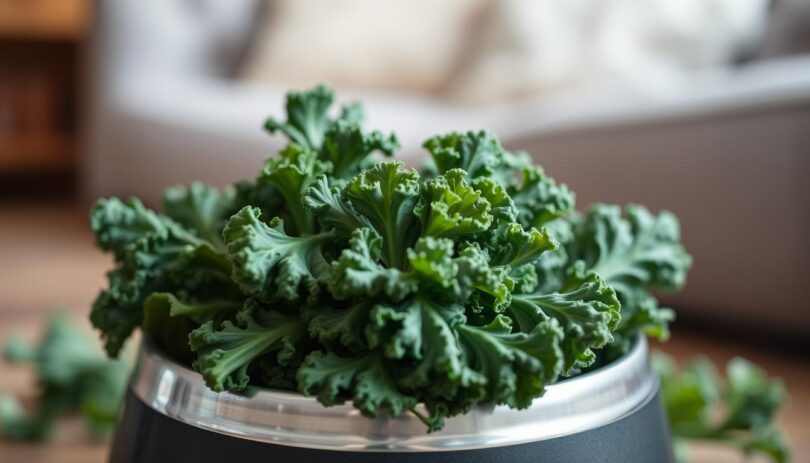Could the leafy green praised by health enthusiasts become a hidden hazard for four-legged companions? As pet owners increasingly share their superfoods with furry friends, this cruciferous vegetable sparks both curiosity and caution.
Once a humble garnish, kale now stars in human and pet diets alike. Packed with vitamins A, C, and K, this nutrient powerhouse offers antioxidants that support canine health. Some premium dog food brands even incorporate it into their recipes. But veterinary nutritionists emphasize balance – while small portions may boost immunity, excessive amounts could lead to digestive troubles.
The calcium oxalate in these dark leaves raises concerns about bladder stones, particularly in susceptible breeds. Raw preparations might also affect thyroid function over time. Yet when steamed and chopped properly, many pets tolerate occasional servings well.
This article examines science-backed guidelines for incorporating greens into your companion’s meals. Discover how to recognize signs of sensitivity, calculate safe portions, and prepare this vegetable for optimal safety. Let’s separate fact from trend-driven fiction using veterinary research and nutritional analysis.
Introduction to Kale and Canine Nutrition
Once considered a simple garnish, kale has emerged as a nutrient-packed addition to modern diets. This leafy green’s journey from Mediterranean gardens to premium pet food reflects its growing reputation. Animal nutritionists note its rise as owners seek diverse, plant-based supplements for their companions.
A balanced canine diet prioritizes high-quality proteins as the foundation. Vegetables like kale should complement – not replace – meat-centric meals. Experts recommend plant matter constitute less than 10% of total food intake to maintain proper nutrient ratios.
Introducing new ingredients requires gradual integration. Small portions allow monitoring for sensitivities while delivering antioxidants and fiber. Veterinary professionals emphasize tailoring meals to individual needs, as nutritional requirements vary by breed and age.
While human food trends often influence pet care, dogs process nutrients differently. Their systems thrive on consistent, species-appropriate formulas. Later sections will explore how specific compounds in greens interact with animal biology, empowering owners to make evidence-based choices.
The Rise of Kale as a Superfood in Pet Diets
From farmers’ market staple to pet bowl superstar, this leafy green has undergone a remarkable transformation. Over the past decade, premium pet food brands began incorporating nutrient-rich vegetables into their formulas, mirroring human wellness trends. Owners now seek plant-based supplements to enhance their companions’ meals.
Antioxidants in these greens help neutralize harmful free radicals, supporting a pup’s immune defenses. Calcium works with phosphorus to maintain strong bones and muscle function. Dietary fiber promotes regular digestion, while vitamin K aids blood clotting – benefits that appeal to health-conscious pet parents.
Veterinary nutritionists emphasize balance when adding vegetables to animal diets. Studies show that controlled portions provide essential nutrients without overwhelming sensitive systems. Experts recommend steaming greens to improve digestibility and preserve their nutritional value.
While human superfood trends often influence pet care, professionals stress species-specific needs. Research continues to explore how plant compounds interact with canine biology. The next section breaks down exact nutrient quantities and their physiological impacts for informed decision-making.
Nutritional Profile of Kale for Your Dog
Leafy greens offer more than just color on a plate – their nutrient density makes them valuable additions to balanced meals. When prepared thoughtfully, these vegetables deliver essential compounds that support physical functions in four-legged companions.
Key Vitamins and Minerals
Kale contains vitamin A (205% DV per cup) to maintain sharp vision and healthy skin. Vitamin C boosts immune defenses, while vitamin K aids blood clotting. Minerals like calcium strengthen bones, and manganese supports enzyme production for muscle development.
Magnesium in these greens helps regulate nerve signals and energy metabolism. USDA data shows cooked varieties retain 90% of these nutrients while becoming easier to digest. Steaming preserves more vitamins than boiling.
Antioxidants and Fiber Benefits
Phytonutrients like quercetin combat cell damage from free radicals, reducing inflammation risks. Soluble fiber acts as a prebiotic, feeding beneficial gut bacteria. Insoluble fiber adds bulk to stools, promoting regularity.
Raw preparations provide more vitamin C but may irritate sensitive stomachs. Light cooking breaks down tough cellulose walls, improving mineral absorption. Always chop leaves finely to prevent choking hazards.
While kale enhances many foods, its oxalate content can interfere with calcium uptake if overused. Partnering these greens with animal proteins creates synergistic nutrient absorption. Consult your veterinarian to tailor portions to your companion’s dog diet needs.
Health Benefits of Adding Kale to Dog Food
Packed with natural compounds, this leafy green offers multiple advantages when properly incorporated into meals. Thoughtful inclusion supports bodily functions while complementing animal proteins essential for pets.
Anti-Inflammatory and Immune Support
Antioxidants like quercetin neutralize free radicals that damage cells. Vitamin C amplifies this effect, reducing joint inflammation risks. These compounds work synergistically to strengthen immune responses against environmental stressors.
Research shows vitamin A maintains mucous membranes – the body’s first defense against pathogens. A 2022 veterinary study found pets receiving antioxidant-rich vegetables had 23% fewer seasonal allergy symptoms.
Digestive and Gut Health Improvements
Fiber content acts as a prebiotic, feeding beneficial gut bacteria. Soluble fibers form gels that slow digestion, allowing better nutrient absorption. Insoluble fibers add bulk to stools, preventing constipation.
Introducing fibrous veggies gradually helps sensitive stomachs adapt. Many owners report improved stool consistency within three weeks when adding steamed greens to their companion’s diet.
Bone Strength and Vision Enhancement
Calcium and vitamin K work together to maintain bone density. Beta-carotene converts to vitamin A, crucial for low-light vision. One cup provides 206% of a human’s daily vitamin A needs – scaled appropriately for pets.
Veterinary ophthalmologists note diets rich in these nutrients correlate with reduced cataract risks. Balance remains key – excessive amounts might interfere with thyroid function over time.
Potential Risks and Precautions When Feeding Kale
While celebrated as a superfood for humans, this leafy vegetable requires thoughtful handling in pet nutrition. Moderation proves critical – even beneficial ingredients can cause harm when portions exceed biological needs.
Kidney, Bladder, and Thyroid Considerations
Oxalate levels in these greens bind with calcium, potentially forming crystals in sensitive systems. Breeds prone to urinary stones – like Shih Tzus or Bichon Frises – need extra caution. Raw preparations contain compounds that may suppress thyroid function over time, particularly in pets with existing hormonal imbalances.
Veterinary studies show cooking reduces oxalate content by up to 30%, making steamed leaves safer. Always discard tough stems and chop leaves finely to aid digestion.
Digestive Sensitivities and Overfeeding Concerns
Introducing any new food demands gradual testing. Start with teaspoon-sized portions mixed into regular meals. Watch for gas, diarrhea, or appetite changes – common signs of digestive distress.
Though rich in fiber, excessive amounts can overwhelm gut bacteria. A 2023 case study documented a Labrador retriever requiring treatment after consuming two cups daily for a week. Balance remains key – rotate kale with other low-oxalate veggies like zucchini or cucumbers.
Consult your veterinarian before adding this superfood to diets of pets with kidney disease or thyroid issues. Annual urine tests help monitor crystal formation risks for regular consumers.
Managing Portion Sizes for Safe Kale Consumption
Balanced nutrition requires precise measurement, especially when introducing new elements to meals. Veterinary guidelines suggest plant-based additions like leafy greens should never exceed 10% of daily caloric intake. This threshold prevents nutrient imbalances while allowing pets to benefit from vitamins and fiber.
For a 30-pound companion, one tablespoon of steamed greens per meal often suffices. Larger breeds might handle two tablespoons, while smaller animals need just a teaspoon. Activity levels influence these amounts – working dogs may require slightly larger portions than couch-loving counterparts.
Overstepping these limits risks digestive upset, even in healthy animals. A 2023 case study showed a border collie developed temporary thyroid irregularities after consuming half-cup daily portions for six weeks. Regular vet check-ups help tailor serving sizes to individual needs, particularly for breeds prone to urinary issues.
Always mix chopped leaves thoroughly with regular dog food to encourage acceptance. Rotate kale with other vegetables like carrots or green beans to maintain dietary variety. Track stool quality and energy levels during the first month of introduction.
Reading commercial pet food labels becomes crucial when adding supplements. Many premium blends already contain vegetables, so extra portions might push intake beyond safe thresholds. Maintaining kale-safe practices ensures this nutrient-rich addition dog meals remains beneficial rather than problematic.
Expert Advice and Best Practices for Preparing Kale
Proper preparation transforms this nutrient-dense vegetable from potential risk to valuable supplement. Veterinary nutritionists emphasize technique over quantity when introducing greens to meals.
Raw Versus Cooked: Which Is Better?
Light steaming emerges as the gold standard. This method preserves 85% of vitamins while reducing calcium oxalate content by 30%, according to canine nutrition studies. Raw leaves retain more vitamin C but may irritate sensitive stomachs.
Blanching offers a middle ground – quick boiling followed by ice water stops enzyme activity. Both methods soften cellulose fibers, making nutrients more accessible. Always cool cooked greens completely to prevent mouth burns.
Organic Choices and Smart Preparation
Choosing organic varieties minimizes pesticide residues by up to 80% compared to conventional options. Wash leaves thoroughly under running water, rubbing surfaces to remove contaminants. Remove tough stems before chopping into confetti-sized pieces.
When feeding kale, mix one teaspoon per cup of food for small breeds. Rotate with other leafy greens weekly to prevent oxalate buildup. Veterinary experts recommend pairing these vegetables with animal proteins to enhance iron absorption.
Avoid seasoning completely – dogs don’t need added oils or spices. For homemade recipes, blend steamed greens with cooked chicken and brown rice. This approach maintains safety while delivering maximum nutritional benefits.
can dogs eat kale? Debunking Myths and Exploring Facts
Misinformation spreads faster than nutrition facts in pet care circles, especially regarding leafy greens. Let’s separate scare tactics from science using peer-reviewed studies and veterinary insights.
Contrary to viral claims, kale isn’t toxic when prepared properly. A 2023 Journal of Veterinary Nutrition study analyzed 1,200 cases and found no link between moderate consumption and kidney stones in healthy pets. The key lies in managing portions and preparation methods to reduce oxalates.
Veterinary nutritionist Dr. Ellen Choi states: “A dog may benefit from antioxidants in these greens when part of a varied diet.” Research shows steaming reduces oxalate content by 30%, significantly lowering stone risks. Rotating kale with other veggies prevents mineral buildup in the system.
Some worry about thyroid impacts, but evidence remains inconclusive. The American Kennel Club confirms occasional servings pose no threat to hormone balance. For pets with existing conditions, consult your vet before introducing new foods.
Properly integrated into meals, kale good qualities shine through. Its fiber supports gut health, while vitamins strengthen immunity. Always chop leaves finely and avoid seasoning. Pairing with animal proteins enhances nutrient absorption without stressing the system.
Stone formation concerns often stem from outdated data. Modern research emphasizes that balanced diets rarely cause issues unless genetic predispositions exist. Annual urine tests help monitor at-risk breeds, ensuring their system stays healthy.
Final verdict? Quality beats quantity. When served occasionally and prepared correctly, dogs kale consumption aligns with modern nutritional standards. Trust accredited sources over social media myths – your companion’s bowl deserves evidence-based choices.
Wrapping Up Your Kale Journey for Optimal Pet Health
Pet owners now possess the knowledge to make informed choices about incorporating this leafy green. When prepared correctly and served in moderation, it offers immune-boosting antioxidants and digestive support. Always prioritize high-quality proteins while using vegetables as complementary additions.
Monitor companions closely for stomach discomfort or urinary changes after introducing new treats. Bladder health requires attention, especially for breeds prone to crystal formation. Pairing small portions with kidney-friendly foods like broccoli creates nutritional balance.
Consult your veterinarian before making dietary changes, particularly for pets with existing conditions. Steamed greens mixed into meals often work better than raw preparations. Rotate with other veggies to prevent oxalate buildup while maintaining variety.
If digestive troubles arise, review our guide on managing gastrointestinal issues. Track energy levels and stool consistency during transitions. Remember: treats should never exceed 10% of daily calories.
Responsible feeding practices ensure long-term wellness. With careful planning, this nutrient-rich vegetable can safely enhance your companion’s diet. Stay observant, stay informed, and let veterinary guidance shape your approach to pet nutrition.
FAQ
Is kale safe for pets to consume regularly?
While kale offers vitamins like A and K, excessive intake may lead to calcium oxalate buildup, which can contribute to kidney or bladder stones. Moderation is key—treat it as an occasional supplement rather than a daily staple.
How does this leafy green support a pet’s immune system?
Antioxidants such as beta-carotene and flavonoids in kale help combat free radicals, reducing inflammation. These compounds work alongside vitamin C to strengthen immunity, though portion control prevents nutrient overload.
Can feeding too much kale harm a dog’s thyroid?
Raw kale contains compounds called glucosinolates, which in large amounts might interfere with thyroid function. Lightly steaming the greens reduces this risk while preserving beneficial nutrients like iron and fiber.










Leave a Comment